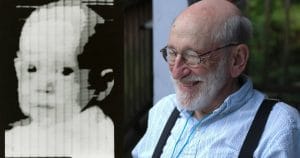The son of immigrants from Russia and Hungary, Kirsch was born in New York City, and attended the Bronx High School of Science, New York University (Bachelor of Electrical Engineering, 1950), Harvard (Master of Science, 1952), and later did graduate work at MIT. In 1951 he accepted a position at the U.S. National Bureau of Standards (now known as the National Institute of Standards and Technology) as part of the team that ran the Bureau’s new Standards Eastern Automatic Computer, the first “stored-program” computer, and the first computer to perform most of its computing operations with solid-state devices — germanium diodes. “My dad, he was a super curious guy, always asking questions,” said his son Walden, who now works at Intel. “He was an iconoclast. When people said you can’t go there or you can’t do that, he did.”

By 1957 he had a lot of experience with SEAC, and a “fortunate happy few” system engineers were allowed to use the computer for “speculative” experiments, Kirsch said in a 1970 interview. (“Sometimes I can confess to having stolen machine time from purportedly more useful products like the thermonuclear weapons calculations and things of this sort,” he admitted, though “This, I think, has been a powerful influence on the development of new uses of computers.”) His own speculative question: “What would happen if a computer could look at the world?” Which is to say, what if computers could see? While analog image scanners (such as fax machines) already existed, a scanner would better work with a computer if it was digital, and Kirsch led the team to design and build the first one. Once complete, they needed an image to try. Rather than a test chart, “I am delighted that he chose to use for that first photo a real, living, tiny, drooling, pink human being,” says Walden — he was born in 1957, and it was his baby picture. That first digital image [above] was only 176 by 176 pixels, or 30,448 pixels total, pretty rough when today’s commercial cameras often exceed 30 megapixels — or 30 million pixels. Oh, and to get there? Kirsch had to “invent” the idea of the pixel. That first scanner could only do “off or on?” for its pixels: black, or white. To get gray tones, they scanned the photo several times at different thresholds, and superimposed them. This early crude work led to a multitude of applications, even beyond digital photography: image processing, pattern recognition, chemical structure searching, transmitting pre-Apollo images back from the moon, the medical CAT scan machine, satellite imaging, barcode scanners, cancer detection, archeology, and more. Kirsch also did early work in acoustic signal (sound) generation, which laid the groundwork for speech synthesis.
That first scanned photo of Walden was chosen by Life magazine in 2003 as one of 100 Photographs that Changed the World*. Kirsch admitted later that making pixels square was “a bad idea,” but it’s what they could do at the time. Part of the design of the original digital scanner was “edge detection” — the Kirsch Operator (or Kirsch Compas Kernal) equation is named for him. He retired from NIST after 33 years as the head of the Artificial Intelligence Group, and stayed affiliated with them as a research scientist for 17 more years. He and his wife moved to Portland, Ore., in 2001, and he died at his home there on August 11 from Alzheimer’s disease. He was 91.
